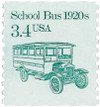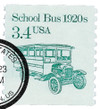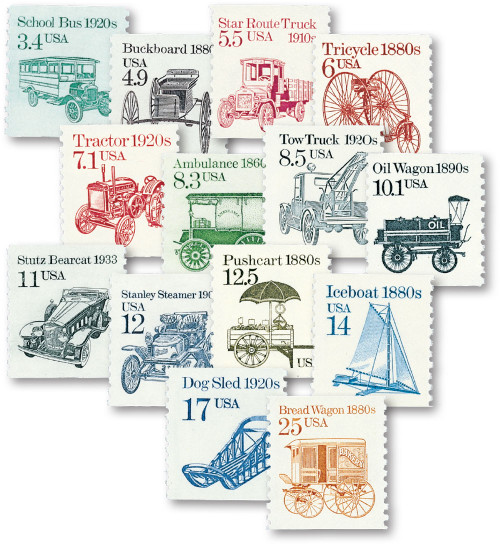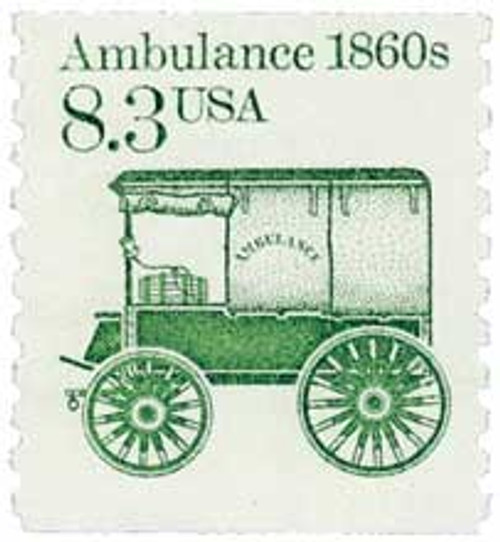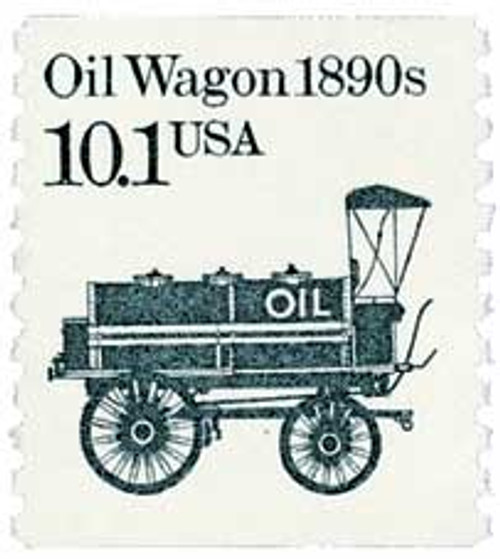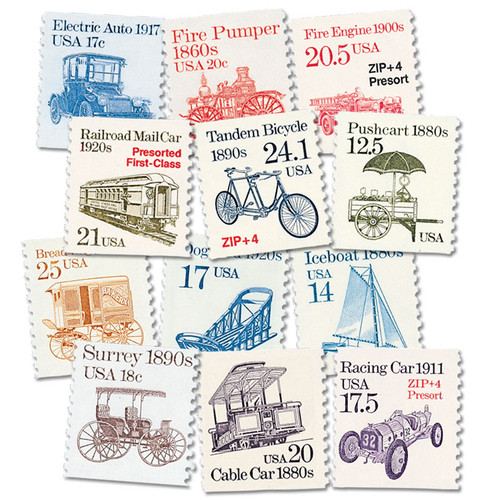
# 2123 - 1985 3.4c Transportation Series: School Bus, 1920s
U.S. #2123
1985 3.4¢ School Bus, 1920s
Transportation Series
- First US stamp ever issued for this rate
- 20th coil stamp in the Transportation Series; sixth in the series issued in 1985
Stamp Category: Definitive
Series: Transportation
Value: 3.4¢; rate for nonprofit, third-class mail presorted and packaged by carrier route
First Day of Issue: June 8, 1985
First Day City: Arlington, Virginia
Quantity Issued: 15,500,000
Printed by: Bureau of Engraving and Printing
Printing Method: Engraved
Format: Coils of 500 and 3,000
Perforations: 10 Vertical
Color: dark bluish green
Why the stamp was issued: This stamp was issued with a similar purpose to the 6¢ tricycle stamp – both were used on nonprofit third-class mail. The 6¢ stamp handled the rate for mail sorted to within the first three digits of the zip code. To use the 3.4¢ stamp, mail had to be sorted and packaged according to carrier route. This much higher level of sorting by bulk mailers allowed them to save 2.6¢ for every piece of mail sent. With many bulk mailers sending out tens of thousands of pieces, that savings really adds up fast.
About the stamp design: The National School Transportation Association of Springfield, Virginia had been calling for a stamp to feature a school bus for several years. This was the first stamp design for artist Lou Nolan, who based his stamp art on a photograph of Blue Bird No. 1. The first bus built by the Bluebird Body Company of Fort Valley Georgia, it had a Ford Model T chassis and was one of the first buses made of steel rather than wood.
Special design details: The 3.4¢ School Bus stamp was available with and without a precancel. #2123 has no precancel, while #2123a has a precancel. Precancels are stamps canceled before being sold, to make mailing faster and cheaper for customers with large amounts of mail. Bulk mailers use precancels, then pre-sort their mail and save money. The USPS makes these stamps available with and without precancels for two reasons. One reason is to create another variety for stamp collectors. The other, is so the stamps can be used as add-on postage for packages slightly overweight.
First Day City: This stamp was issued at the second day of the NAPEX ’85 stamp show in Arlington, Virginia.
About the Transportation Series: On May 18, 1981, the USPS issued the first stamp in the Transportation Series, US #1907, picturing the Surrey, a doorless four-wheeled carriage. For the first time in US history, a coil stamp featured its own unique design rather than simply copying that of the current definitive stamp. Over 50 more coil stamps would be issued over the course of the next 15 years, each picturing a different mode of transportation. All of these types of transportation were used since American independence.
The various denominations provided face values to exactly match the rates for several categories of Third-Class mail (bulk rate and quantity-discounted mail). As the rates changed, new stamps with new values were added. Never before had a stamp series included so many fractional cent values.
The Bureau of Engraving and Printing printed most of the stamps in the Transportation Series, although private contractors printed a few. All but a few of the later stamps were produced by engraved intaglio. Differences in precancels, tagging, paper and gum provide a large number of varieties.
Scott Catalog separates the Transportation stamps into four groups. The stamps in the first group (#1897-1908) generally have the denomination in small type with a “c” next to it. These stamps were printed on the Cottrell rotary press, which joined together two plates to make a sleeve. The gaps between these plates created depressions where ink would collect and create joint lines on the stamps. Later issues were printed on a different press and didn’t have these joint lines.
The second group (#2123-36) had larger numbers with no “c.” The third group (#2252-66) was similar in appearance to the second group, but service inscriptions were added to the designs. These stamps also used a variety of paper and gum as well as different types of tagging. The fourth group (#2451-68) marked the end of fractional values. Now bulk mailers would use either the 5¢ or 10¢ stamp and then pay the difference from the actual postage rate.
The last stamp in the Transportation Series, the 20¢ Cog Railway, was issued on June 9, 1995, at the TEXPEX ’95 stamp show in Dallas, Texas. This marked the end of the largest US definitive series up to that time. Three new series would eventually replace it – American Transportation, American Culture, and American Scenes. Additionally, the Great Americans would go on to become the largest American definitive series.
History the stamp represents: In the early days, the only way most children could get to school was by walking. Halfway through the 19th century, that began to change with the introduction of “kid hacks.” These were horse-drawn carriages designed to carry children to school. They were primitive and didn’t have much protection from the elements, but they marked the beginning of the history of school buses.
The first “horseless” school bus was produced by Wayne Works in 1914. Five years later, the use of school buses was funded in all 48 US states. Buses went through a number of innovations in the next twenty years or so. By the 1930s, the design had pretty much settled to the style we know today. It was also around this time that “National School Bus Glossy Yellow” became the standard color for all school buses.
As the years passed, more safety features were added, making today’s school buses some of the safest vehicles on the roads. In fact, according to the National Highway Traffic Safety Administration and National Transportation Safety Board, riding a school bus is more than 70 times safer than riding in a regular car. That’s good news for the over 27 million American children who travel to and from school by bus every day!
U.S. #2123
1985 3.4¢ School Bus, 1920s
Transportation Series
- First US stamp ever issued for this rate
- 20th coil stamp in the Transportation Series; sixth in the series issued in 1985
Stamp Category: Definitive
Series: Transportation
Value: 3.4¢; rate for nonprofit, third-class mail presorted and packaged by carrier route
First Day of Issue: June 8, 1985
First Day City: Arlington, Virginia
Quantity Issued: 15,500,000
Printed by: Bureau of Engraving and Printing
Printing Method: Engraved
Format: Coils of 500 and 3,000
Perforations: 10 Vertical
Color: dark bluish green
Why the stamp was issued: This stamp was issued with a similar purpose to the 6¢ tricycle stamp – both were used on nonprofit third-class mail. The 6¢ stamp handled the rate for mail sorted to within the first three digits of the zip code. To use the 3.4¢ stamp, mail had to be sorted and packaged according to carrier route. This much higher level of sorting by bulk mailers allowed them to save 2.6¢ for every piece of mail sent. With many bulk mailers sending out tens of thousands of pieces, that savings really adds up fast.
About the stamp design: The National School Transportation Association of Springfield, Virginia had been calling for a stamp to feature a school bus for several years. This was the first stamp design for artist Lou Nolan, who based his stamp art on a photograph of Blue Bird No. 1. The first bus built by the Bluebird Body Company of Fort Valley Georgia, it had a Ford Model T chassis and was one of the first buses made of steel rather than wood.
Special design details: The 3.4¢ School Bus stamp was available with and without a precancel. #2123 has no precancel, while #2123a has a precancel. Precancels are stamps canceled before being sold, to make mailing faster and cheaper for customers with large amounts of mail. Bulk mailers use precancels, then pre-sort their mail and save money. The USPS makes these stamps available with and without precancels for two reasons. One reason is to create another variety for stamp collectors. The other, is so the stamps can be used as add-on postage for packages slightly overweight.
First Day City: This stamp was issued at the second day of the NAPEX ’85 stamp show in Arlington, Virginia.
About the Transportation Series: On May 18, 1981, the USPS issued the first stamp in the Transportation Series, US #1907, picturing the Surrey, a doorless four-wheeled carriage. For the first time in US history, a coil stamp featured its own unique design rather than simply copying that of the current definitive stamp. Over 50 more coil stamps would be issued over the course of the next 15 years, each picturing a different mode of transportation. All of these types of transportation were used since American independence.
The various denominations provided face values to exactly match the rates for several categories of Third-Class mail (bulk rate and quantity-discounted mail). As the rates changed, new stamps with new values were added. Never before had a stamp series included so many fractional cent values.
The Bureau of Engraving and Printing printed most of the stamps in the Transportation Series, although private contractors printed a few. All but a few of the later stamps were produced by engraved intaglio. Differences in precancels, tagging, paper and gum provide a large number of varieties.
Scott Catalog separates the Transportation stamps into four groups. The stamps in the first group (#1897-1908) generally have the denomination in small type with a “c” next to it. These stamps were printed on the Cottrell rotary press, which joined together two plates to make a sleeve. The gaps between these plates created depressions where ink would collect and create joint lines on the stamps. Later issues were printed on a different press and didn’t have these joint lines.
The second group (#2123-36) had larger numbers with no “c.” The third group (#2252-66) was similar in appearance to the second group, but service inscriptions were added to the designs. These stamps also used a variety of paper and gum as well as different types of tagging. The fourth group (#2451-68) marked the end of fractional values. Now bulk mailers would use either the 5¢ or 10¢ stamp and then pay the difference from the actual postage rate.
The last stamp in the Transportation Series, the 20¢ Cog Railway, was issued on June 9, 1995, at the TEXPEX ’95 stamp show in Dallas, Texas. This marked the end of the largest US definitive series up to that time. Three new series would eventually replace it – American Transportation, American Culture, and American Scenes. Additionally, the Great Americans would go on to become the largest American definitive series.
History the stamp represents: In the early days, the only way most children could get to school was by walking. Halfway through the 19th century, that began to change with the introduction of “kid hacks.” These were horse-drawn carriages designed to carry children to school. They were primitive and didn’t have much protection from the elements, but they marked the beginning of the history of school buses.
The first “horseless” school bus was produced by Wayne Works in 1914. Five years later, the use of school buses was funded in all 48 US states. Buses went through a number of innovations in the next twenty years or so. By the 1930s, the design had pretty much settled to the style we know today. It was also around this time that “National School Bus Glossy Yellow” became the standard color for all school buses.
As the years passed, more safety features were added, making today’s school buses some of the safest vehicles on the roads. In fact, according to the National Highway Traffic Safety Administration and National Transportation Safety Board, riding a school bus is more than 70 times safer than riding in a regular car. That’s good news for the over 27 million American children who travel to and from school by bus every day!






